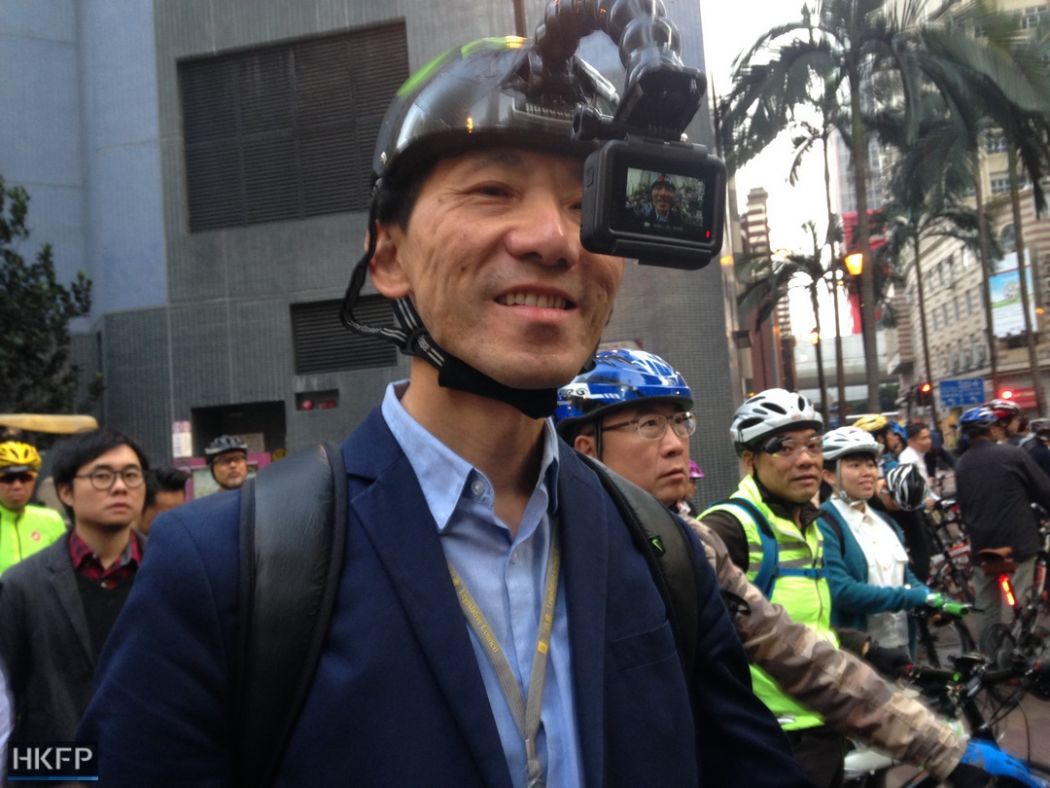Around 100 Hongkongers participated in a bike ride from Sheung Wan to Taikoo Place early Tuesday morning as part of a project to promote commuting by bicycle.
The ride was organised by lifestyle websites Bike the Moment and Rideout in conjunction with lawmaker Edward Yiu to promote a bike-friendly city. 101 riders registered on the Facebook page to take part in the ride that began at the Recreation and Fitness Centre in Sheung Wan and ended at Taikoo Place, with stops along the route for other participants to join.
“We have about a hundred participants, and we are going to have our bicycle track made by ourselves, and people are not just [here] for fun, but they are also riding bicycles for commuting,” Yiu told HKFP.

Tuesday’s event was the last morning bike ride of the season – the culmination of a series of weekly bike rides that began in November. The organisers said they decided from the start that if they could get 100 people to attend the final ride, they would try to launch a Kowloon route next year.
“It’s very rare that we have about a hundred bicycles together,” Yiu told the group before they set out. “Let’s set out together today and create our own bicycle track.”
The name “Tin Kwong Ride” – meaning dawn ride – came from the Cantonese term for dawn markets, which open early in the morning. Vendors would set up their stalls on the sidewalks before anyone is out. The organisers aimed to do the same with their morning rides – to get on the road before it is filled with drivers, as a way to test the infrastructure and get more cyclists on the road.

Tin Kwong Rides have been held every Tuesday. Cyclists usually start before rush hour, around 7am, and return home by bike at around 7pm.
The last Tin Kwong Ride of the season was scheduled to be held last week, but it was rescheduled due to rain.
Urban cycling risks
The government has been criticised for not doing enough to encourage cycling.
CY Leung said in his 2017 policy address that the government will provide “comprehensive cycle track networks” in new development areas such as Yuen Long South and Hung Shui Kiu. It will also build a cycle track of about 82 kilometres to connect the eastern and western parts of the New Territories by linking up separate sections of cycle paths in the area.

But in urban areas, the government’s position is that it does not have plans to designate priority lanes for bicycles in the areas, owing to limited road space.
Secretary for Transport and Housing Anthony Cheung said in February that cycling in urban areas carries risks: “If dedicated cycle lanes are to be designated on the road space, the existing walkways or carriageways will need to be narrowed, inevitably bringing inconvenience to other road users or aggravating road traffic congestion, and easily causing traffic accidents. Allowing a large number of bicycles to share the busy roads in urban areas with other vehicles without dedicated cycle tracks will also increase the risks of accidents.”

Rather than waiting for the government to designate bike lanes, Yiu proposed the Tin Kwong Ride as a way for cyclists to “create their own” by promoting a bike culture. He said it creates a safe way for people to start cycling and assess the infrastructure for cyclists on Hong Kong Island.
“The simplest solution is – the more people there are cycling, the safer it is,” he said in September. “If other drivers know that there will be a lot of cyclists on the road at that time, they will know how to follow the rules of the road and at the same time it will reduce the amount of people driving. So that will improve air quality and prevent congestion.”
“This is the first time, and very successful, and we hope the government will listen to our request and provide bicycle lanes,” Yiu told HKFP on Tuesday.
The organisers are also fundraising to conduct a study on the feasibility of setting up bike lanes on Hong Kong Island, in addition to a documentary related to the project.
